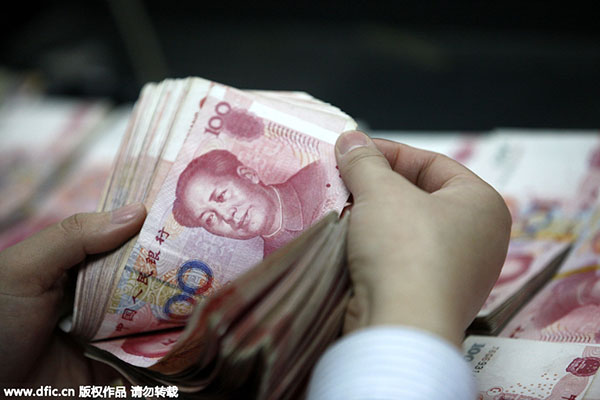China's yuan weakens most in two decades after central bank reform
Updated: 2015-08-11 12:10
(Agencies)
|
|||||||||||
 |
|
A Chinese clerk counts RMB (renminbi) yuan banknotes at a bank in Huaibei city, East China's Anhui province, January 22, 2015. |
China's yuan weakened sharply in early trade on Tuesday, heading for its biggest one-day drop after the central bank surprised the market with reforms that paved the way for the currency's depreciation.
The People's Bank of China cut its daily reference rate for the currency by a record 1.9 percent, triggering the yuan's biggest one-day loss since China unified official and market exchange rates in January 1994.
The change was a one-time adjustment, the central bank said in a statement, adding that it plans to keep the yuan stable at a "reasonable" level and will strengthen the market's role in determining the fixing.
PBOC said in the statement it was now basing the yuan's midpoint on market makers' quotes and the previous day's closing price. The yuan midpoint weakened to 6.2298 per dollar, compared with the 6.1162 mid-point on Monday, its biggest move in the fixing on record.
"It looks like this is the end of the fixing as we know it," Bloomberg News cited Khoon Goh, a Singapore-based strategist at Australia & New Zealand Banking Group Ltd. "The one-off devaluation of the fix and allowing more market-based determination takes us into a new currency regime."
The news agency said the PBOC had been supporting the yuan to deter capital outflows and encourage greater global usage as China pushes for official reserve status at the International Monetary Fund. The intervention contributed to a $300 billion slide in the nation's foreign-exchange reserves over the last four quarters and made the yuan the best performer in emerging markets, eroding the competitiveness of Chinese exports.
The currency dropped 1.4 percent to 6.2980 per dollar as of 11:12 am in Shanghai, and slid 1.6 percent in Hong Kong's offshore trading. The onshore spot rate was 1.1 percent weaker than the reference rate of 6.2298, within the 2 percent limit allowed by the central bank.
Related Stories
China improves exchange rate formation system 2015-08-11 10:55
Chinese yuan weakens sharply to 6.2298 against US dollar 2015-08-11 09:54
Govt plans new 100-yuan note that will be harder to fake 2015-08-10 13:44
China's new yuan loans up in July 2015-08-11 09:06
RMB daily trading band to widen in Q3: economist 2015-08-08 10:38
Today's Top News
'Missile fragments' recovered from MH17 site
Chinese yuan extends sharp fall, long-term depreciation unlikely
China's yuan weakens most in two decades after central bank reform
Greece and lenders agree on
bailout terms
Attacks kill 9 at US consulate
in Turkey
To boost tourism, consumption, govt suggests longer weekend
Greece, lenders in stretch run to to seal new bailout
State Council approves plan to overhaul SOEs, claims report
Hot Topics
Lunar probe , China growth forecasts, Emission rules get tougher, China seen through 'colored lens', International board,
Editor's Picks

|

|

|

|

|

|






